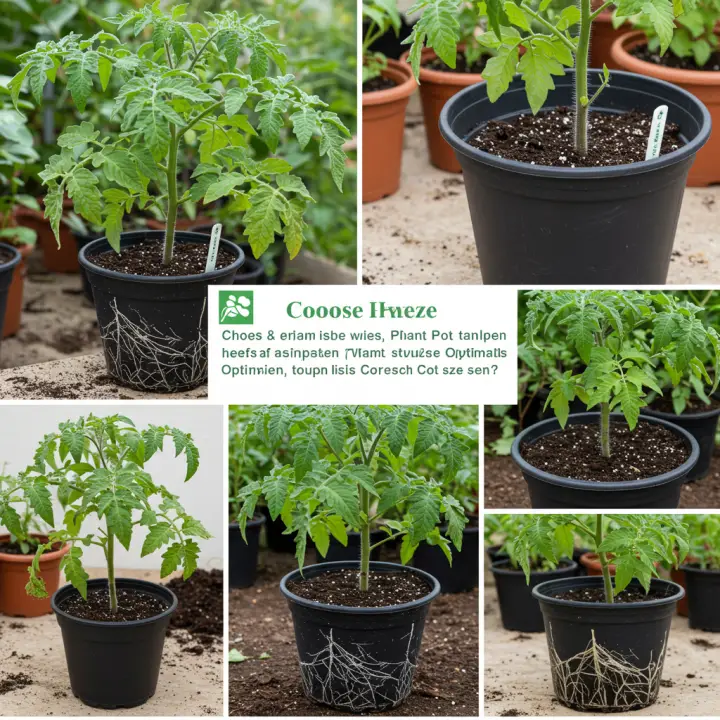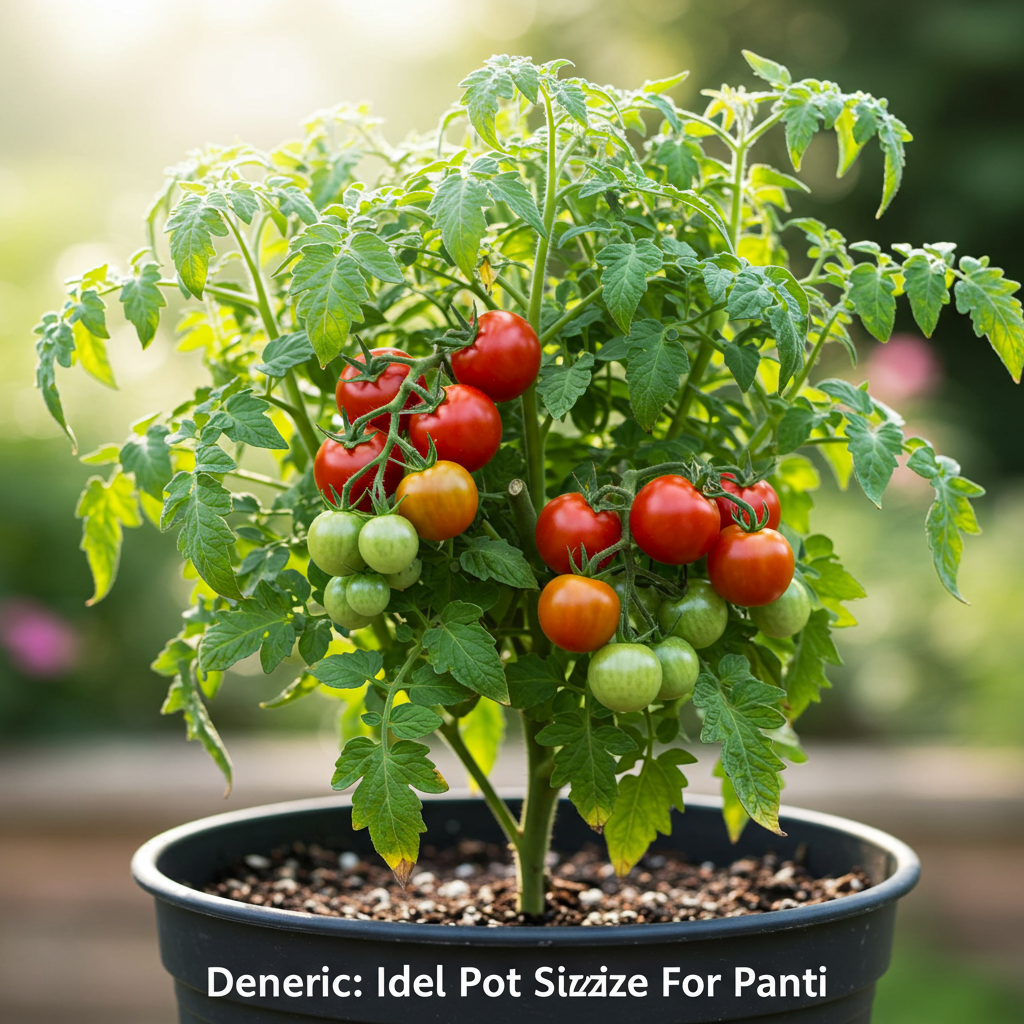Tomato plant pot selection is one of the most critical decisions you will make on your journey to a bountiful harvest of juicy, homegrown tomatoes. It’s a foundational step that, if overlooked, can lead to frustration, stunted plants, and a disappointing yield. While it’s tempting to grab any container you have lying around, understanding the specific needs of a tomato plant’s root system is the secret to unlocking its full potential. This guide will walk you through everything you need to know, from the science behind pot size to specific recommendations for every type of tomato, ensuring your container gardening efforts are rewarded with vibrant, healthy, and productive plants.
Why Pot Size Is the Most Important Decision You’ll Make

Before we dive into specific gallon sizes and measurements, it’s essential to understand why the volume of soil is so vital for a thirsty, hungry plant like a tomato. It’s not just about giving the plant a place to sit; it’s about creating a stable, life-sustaining ecosystem.
The Power of a Healthy Root System
Imagine a large, majestic tree. You instinctively know that beneath the surface lies an equally vast and complex network of roots anchoring it and drawing up water and nutrients. A tomato plant is no different, just on a smaller scale. Its roots are its engine. In a pot that is too small, the roots quickly hit the walls and begin to circle, becoming a dense, tangled mat. This condition, known as being “root-bound,” severely restricts the plant’s ability to function. A constricted root system cannot efficiently absorb water or nutrients, leading directly to a weak and underperforming plant. A larger pot allows the roots to spread out freely, creating a robust network that can support vigorous top growth and heavy fruit production.
The Water and Nutrient Buffer
A larger volume of soil acts as a crucial reservoir for both water and nutrients. Consider a small pot on a hot summer day. The limited amount of soil will dry out incredibly fast, sometimes in just a few hours. This creates a stressful cycle of wilting and recovery for the plant. Furthermore, frequent watering flushes essential nutrients out of the small soil volume, requiring you to fertilize constantly.
In contrast, a large pot holds significantly more moisture. It provides a buffer, meaning you don’t have to water as obsessively, and the moisture level remains more consistent. This consistency is key to preventing problems like blossom end rot, which is often caused by fluctuating water levels and the subsequent inability of the plant to uptake calcium. Similarly, a larger soil mass can hold onto nutrients for longer, providing a more stable food source for your hungry tomato.
Stability and Support
Tomato plants, especially indeterminate varieties, can grow into large, heavy beasts laden with fruit. A small, lightweight pot is an accident waiting to happen. A strong gust of wind can easily topple it, damaging the plant and its precious fruit. A larger, heavier pot filled with soil provides a solid anchor, ensuring your plant stays upright and secure, even when it’s six feet tall and covered in beefsteaks.
Matching Tomato Variety to Pot Size: The Golden Rules
The single most important factor in choosing a pot size is the mature size of your tomato variety. Tomatoes are generally categorized into two main growth habits: determinate and indeterminate. Understanding which type you have is non-negotiable.
Determinate vs. Indeterminate: The Crucial Distinction
Determinate (Bush) Tomatoes: These varieties grow to a predetermined, compact size (usually 2-4 feet tall). They produce their foliage first, then set flowers and fruit in a concentrated period. Once this main crop is produced, the plant’s life cycle is largely complete. Because of their manageable size, they are ideal for container gardening. Examples: Roma, Celebrity, Bush Goliath, Patio.
Indeterminate (Vining) Tomatoes: These are the wild ones. Indeterminate tomatoes will continue to grow, flower, and produce fruit all season long until they are killed by frost. They don’t have a set size and can easily reach heights of 6-10 feet or more. They require substantial staking or caging and, consequently, a very large container to support their massive size and extensive root system. Examples: Big Boy, Beefsteak, Brandywine, most heirloom and cherry tomato varieties like Sungold.
The Ultimate Pot Size Guide
Armed with the knowledge of your tomato type, you can now choose the right container.
Micro-Dwarf Varieties (e.g., Tiny Tim, Micro-Tom)
These are the exceptions to the rule. Specifically bred for windowsill gardening and tiny spaces, these miniature plants only grow about 6-12 inches tall.
Minimum Pot Size: 1 gallon (approx. 6-7 inches in diameter)
Recommended Pot Size: 2-3 gallons (approx. 8-10 inches in diameter)
Verdict: A 2-gallon pot will give these tiny wonders enough room to thrive without the risk of drying out too quickly that a 1-gallon pot presents.
Determinate (Bush) Varieties (e.g., Roma, Celebrity)
This is the category where most container gardeners live. The standard advice you often hear—”use a 5-gallon bucket”—is aimed at these types.
Absolute Minimum Pot Size: 5 gallons (approx. 12 inches in diameter)
Ideal Recommended Pot Size: 7-10 gallons (approx. 14-16 inches in diameter)
Verdict: While you can grow a determinate tomato in a 5-gallon pot, the plant will be much happier, less stressed, and more productive in a 7- or 10-gallon container. The extra root space and water-holding capacity of a slightly larger pot make a noticeable difference in plant health and final harvest size.
Indeterminate (Vining) Varieties (e.g., Beefsteak, Brandywine, Sungold)
This is where many gardeners make a critical mistake. Trying to grow one of these vining giants in a 5-gallon pot is a recipe for disappointment. Their root systems are enormous and their thirst for water is immense.
Absolute Minimum Pot Size: 15 gallons (approx. 18 inches in diameter)
Ideal Recommended Pot Size: 20-25 gallons (approx. 20-24 inches in diameter)
Verdict: For indeterminate tomatoes, bigger is always better. A 20-gallon pot or even a half-whiskey barrel provides the root space, stability, and water buffer needed for these plants to reach their full, glorious potential. You will be rewarded with a longer harvest period and larger, more abundant fruit.
The Consequences of Using the Wrong Size Tomato Plant Pot
So what actually happens if you ignore this advice? The plant won’t necessarily die, but it will certainly fail to thrive.
When the Pot is Too Small:
Stunted Growth: The plant will remain small and weak, with yellowing leaves and thin stems.
Poor Fruit Production: You will get significantly fewer tomatoes, and the ones that do grow will be smaller than the variety’s potential.
Increased Risk of Blossom End Rot: Small pots dry out quickly. This inconsistent watering prevents the plant from properly absorbing calcium, leading to the classic black, leathery patches on the bottom of the fruit.
Constant Chores:** You will

